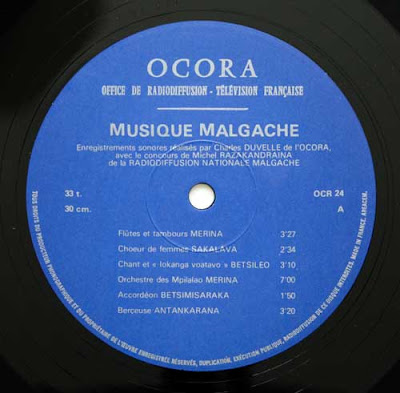Nigéria - Musiques du plateau
Angas, Birom, Jarawa, Burom, Yergam, Pyem
Recorded in 1972 by Benoît Quersin
Institute of African Studies
Ocora - OCR-82 - 1974?
Side A
1 Deng-deng
- chanson avec accompagnement de harp molo 3'14
2 Solo de xylophone kundung 3'02
3 Bwana
- chanson avec accompagnement de harp molo 2'00
4 Chanson de Angas
- chanson avec accompagnement de chitare molo 3'35
5 Chanson de Pyem
- chanson avec accompagnement de chitare molo 6'05
6 Ensemble de flûtes sharawa, et tambours du village 4'20
Side B
1 Ensemble de sifflets izur nfiko 2'30
2 Musique Komtin - chœur et idiophones 4'53
3 Orchestre de molo de Maisage Zindam Ndam 5'25
4 Orchestre de molo de Zhimak Tyem 2'44
5 Danse Wasam Burum avec tambours 3'08
6 Danse et chants Kida manoma 2'45
7 Vièles monochordes goge 1'50

I posted some Nigerian recordings recently released on the lable Bärenreiter and here is another Nigerian but on the no less prestigious lable Ocora. There are some very good tracks here that I hope you will enjoy!
Here is a quote from the sleeve:
The Jos Plateau, where the recordings on this record were made, rises to an average height of twelve hundred metres in the centre of Nigeria. It makes up the northern extreme of Benue-PlateauState. one of the twelve states of the Federal Republic of Nigeria. politically reorganized since 1967. Without doubt the countryside includes some of the most beautiful in western Africa, and the climate of these highlands gives it a Mediterranean appeal. But what the plateau is particularily known for is the discovery of rich veins of tin just below the surface. the exploitation of which brought to light surprising archeological remains. These reveal the existence of a very old civilization (800 BC to 200 AD) where an iron industry was wide-spread and where art had reached a high level : the "Nok Culture''.
If this civilization fortold the states which were to appear in the neighbouring districts from after the eleventh century. their creators are not the ancestors of the present day plateau populations : these forty or so tribes and sub-tribes of various origins, each possessing its own language and traditions, are as yet largely unknown. With a very independant character. there were for a long time a worry to the British Administration which had wanted, since 1904, to control these "Plateau pagans ", as they were called by the Hausa Moslems.
"Living in their own villages and prefering their own company, they are still largely spectators of the approach of civilisation", remarked a high official in 1933. This is of course no longer true today; but the plateau tribes were amongst the last in Nigeria to accept the change.
Six tribes are represented on this record. If we look at the different traditions, the Pyem originated from a country to the north. Gobir, and were amongst the first wave of immigrants. The Angas remembered having lived in Kanem, and then Bornu before the arrival of the Kanuri pushed them out, towards the 13th or 14th century; from this large tribe several other plateau groups were derived, including the Tal, which in turn gave rise to the Yergam or Talok (signifying "comes from Tal "). The Burum, present neighbours of the Yergam. say they originated from the Jukun, of which they would have been a branch or vassal tribe. During the 16th and 17th centuries, Angas, Burum and Yergam were a part of the Jukun Empire - also called Kororofa - which experienced at the time an extraordinary development with the conquest of the territories east and south of the Plateau, as well as the Kano and Zaria Hausa Kingdoms to the north-west.
This expansion would also have lead the Birom, who lived in the forests to the south, to move to the plateau. The Kororofa State dissolved in the 18th century in circumstances which remain mysterious, and the political and cultural centre moved towards the north: the jihad (holy war) of the great leader Fulani Usman dan Fodio started in 1804 in fact, and in it his followers subdued in some six years all the Hausa States and Jukun dependent outlying Plateau tribes. The interior tribes resisted the invaders. However, the Fulani made little effort to convert or assimilate the “pagans”, being satisfied to collect tributes. Only the Burum are largely islamic. but their case is different. They gave themselves from the beginning of the 18th century a dynasty of Kano origin.
Finally. the few Jarawa groups established not far from Jos, came from the Bauchi Emirat where the large part of the tribe are still found.
Despite their diversity, the Plateau tribes share the same type of existence : an essentially agricultural economy with a few handicrafts (pottery basket-making, weaving, forging). The dwellings are round huts with conical roofs, grouped in circles. Several compounds make a village.
Most of these societies have not developed a centralized political organisation. independant groups rarelv passing one or several villages (Birom), or a section of a tribe (Yergam, Angas). The Pyem had however a ‘supreme chief' with politico-religious functions.
Ancestor cults. with nature spirits, and agricultural fertility rites play an important role (cf. tracks A-2, A-3, and B-1).
The languages belong to the Benoue-Congo branch of the Niger-Congo group, except for the Pyem, which is an Afro-asiatic language.
Kundung xylophone
Molo harpe
Ikpang ichir
Akishak calabash rattles
Raft zither
Harpe and castanets
Wasam burum dance
Goge onestring fiddle
Sistre

Music ▼ +

























































